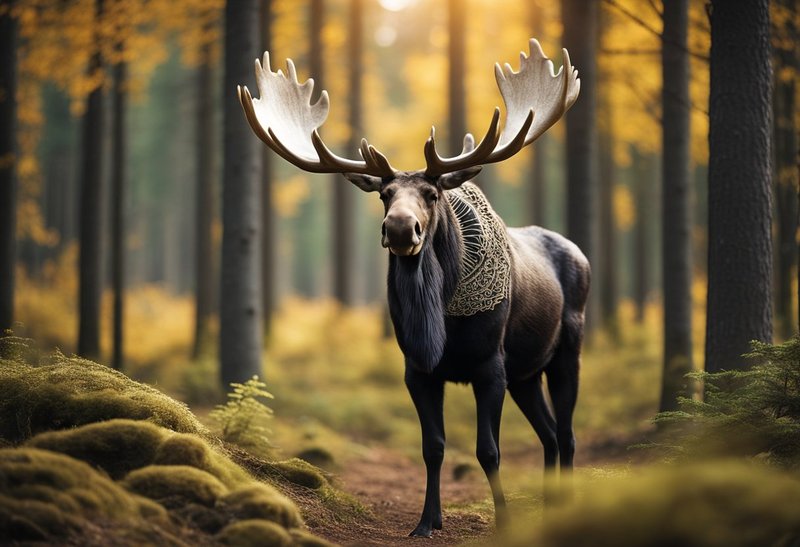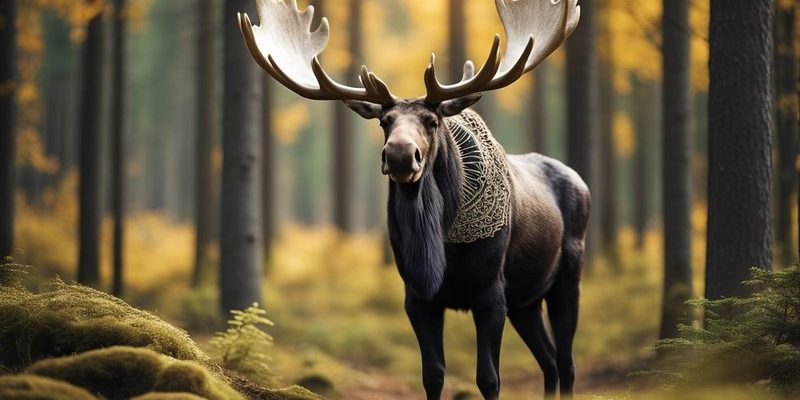
Honestly, moose are fascinating for more reasons than just their size. These animals symbolize strength, endurance, and adaptability, qualities that have drawn people to them for centuries. Whether it’s through Native American legends or European tales, the moose often embodies wisdom and connection to nature. So, grab a coffee, and let’s dive into how the moose has been depicted throughout culture and folklore.
The Moose in Native American Culture
Many Native American tribes view the moose as more than just a wild animal; they see it as a vital part of their spiritual world. For tribes like the Algonquin, the moose represents strength and survival. The animal is often featured in stories that convey important life lessons about respect for nature and the balance of ecosystems.
In these stories, the moose is sometimes portrayed as a wise elder, guiding young animals through challenges. This mirrors how real-life elders in communities often share knowledge with the younger generation. The moose’s ability to thrive in harsh environments symbolizes resilience, teaching lessons about perseverance through difficult times.
Moreover, the moose is significant in various ceremonies and rituals. It’s not uncommon for hunters to offer thanks to the moose for providing food and materials for clothing and tools. This respect for the animal highlights the importance of gratitude and balance within nature—a theme that resonates across many Native American cultures.
Moose in Scandinavian Folklore
In Scandinavian folklore, the moose takes on a fascinating role, often linked to Norse mythology. The moose is associated with the gods, particularly with fertility and strength. In some stories, the moose is considered a guardian of the woods, protecting other creatures and the forest itself.
Interestingly, the moose is sometimes portrayed as a trickster figure, akin to a mischievous character found in many cultural tales. These stories help explain natural occurrences, like the changing seasons or the migration of animals. Imagine listening to a story around a crackling fire, with a wise elder telling you how the moose outsmarted a hunter or helped a lost traveler find their way home. These narratives not only serve entertainment purposes but also pass down knowledge about local wildlife and habitats.
Furthermore, in various parts of Scandinavia, festivals celebrate the moose, highlighting its significance to local communities. You might see artwork featuring moose, from intricate wooden carvings to paintings that capture the animal’s grace and beauty. This celebration of the moose can be seen as a reflection of how intertwined these animals are with the cultural identity.
Moose Representations in Art and Literature
The moose has made a notable impact on art and literature, becoming a symbol of the wilderness and the great outdoors. Artists often choose to depict moose in their natural habitats, showcasing their majesty. Think about hiking through a tranquil forest and stumbling upon a serene lake where a moose is drinking water; this is a moment that many artists strive to capture.
In literature, moose characters often symbolize power and independence. You might come across stories where the moose is the hero, bravely facing challenges in a world that can be harsh and unforgiving. Authors use these powerful animals to transport readers into wild, uncharted territories where nature reigns supreme.
Additionally, moose sightings in stories often provoke feelings of nostalgia and longing for simpler times. They remind us of the beauty and tranquility found in nature. You might be reminded of your own adventures in the woods, adding a personal connection when you read or see them represented in art.
Moose in Modern Popular Culture
In today’s world, the moose has found its way into modern popular culture, popping up in everything from cartoons to social media. You might have seen playful moose characters in animated films, charming children with their goofy antics. These representations often emphasize the moose’s gentle nature and create a relatable figure for audiences.
Merchandising also plays a significant role in how we see moose today. From t-shirts to plush toys, moose-themed products celebrate the animal’s popularity. You might even find moose motifs in home decor, crafting a cozy, rustic vibe. These items connect people to the outdoors and remind them of wildlife’s importance in our lives.
The rise of social media has also given moose a new platform. Pictures and videos of moose in their natural habitats go viral, inspiring discussions about wildlife conservation. As these stories spread, they foster a greater understanding of the challenges moose face in the wild, such as habitat loss and climate change.
Moose Symbolism Across Cultures
Across various cultures, the moose embodies different symbolic meanings. In some societies, moose are seen as a symbol of endurance and strength. This can be attributed to their ability to navigate harsh environments and thrive against the odds. The moose’s massive size often represents power, like the towering trees in its habitat.
In the context of spirituality, the moose can symbolize introspection and insight. Many cultures believe that observing a moose can lead to personal growth and self-discovery. As you watch a moose move, you might find yourself reflecting on your own journey through life. There’s something about their calm presence that invites deep thought and contemplation.
Moreover, in some traditions, the moose is linked to community and protection. Hunters may see the moose as a provider, fulfilling essential needs for food and materials. This connection emphasizes the importance of living harmoniously with nature and respecting the wildlife around us.
The moose is more than just a magnificent creature; it represents cultural heritage, folklore, and the delicate balance of nature. Its presence in various stories and art forms speaks to our collective fascination and appreciation for wildlife. From the wise guardian in Native American tales to the playful character in modern cartoons, the moose continues to inspire and teach us lessons about strength, resilience, and respect.
As we move forward, let’s remember the important role that moose play in our cultural narratives and their impact on conservation efforts. By understanding their significance, we can foster a deeper appreciation for these incredible animals and work towards preserving their habitats for future generations. So the next time you think of a moose, remember it’s not just an animal; it’s a symbol of connection to nature, culture, and the stories that bind us all together.

